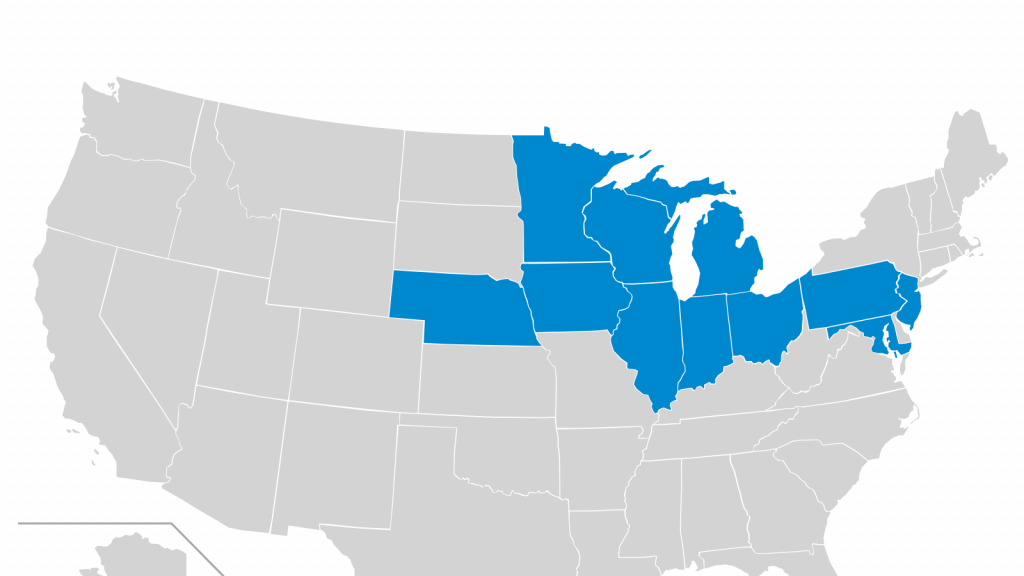Student-centric advice and objective recommendations
Higher education has never been more confusing or expensive. Our goal is to help you navigate the very big decisions related to higher ed with objective information and expert advice. Each piece of content on the site is original, based on extensive research, and reviewed by multiple editors, including a subject matter expert. This ensures that all of our content is up-to-date, useful, accurate, and thorough.
Our reviews and recommendations are based on extensive research, testing, and feedback. We may receive commission from links on our website, but that doesn’t affect our editors’ opinions. Our marketing partners don’t review, approve or endorse our editorial content. It’s accurate to the best of our knowledge when posted. You can find a complete list of our partners here.
What You Need to Know About the Big 10 Schools

 By
Zach Skillings
By
Zach Skillings 
Zach Skillings is the Scholarships360 Newsletter Editor. He specializes in college admissions and strives to answer important questions about higher education. When he’s not contributing to Scholarships360, Zach writes about travel, music, film, and culture. His work has been published in Our State Magazine, Ladygunn Magazine, The Nocturnal Times, and The Lexington Dispatch. Zach graduated from Elon University with a degree in Cinema and Television Arts.
Full BioLearn about our editorial policies

Cece Gilmore is a Content Writer at Scholarships360. Cece earned her undergraduate degree in Journalism and Mass Communications from Arizona State University. While at ASU, she was the education editor as well as a published staff reporter at Downtown Devil. Cece was also the co-host of her own radio show on Blaze Radio ASU.
Full BioLearn about our editorial policies

Maria Geiger is Director of Content at Scholarships360. She is a former online educational technology instructor and adjunct writing instructor. In addition to education reform, Maria’s interests include viewpoint diversity, blended/flipped learning, digital communication, and integrating media/web tools into the curriculum to better facilitate student engagement. Maria earned both a B.A. and an M.A. in English Literature from Monmouth University, an M. Ed. in Education from Monmouth University, and a Virtual Online Teaching Certificate (VOLT) from the University of Pennsylvania.
Full BioLearn about our editorial policies

The Big 10 is a group of universities that belong to one of the premier collegiate athletic conferences in the U.S. Despite what its name suggests, the conference actually consists of 18 colleges. These schools are known for being large institutions with competitive athletic programs and a tremendous amount of school spirit. Big 10 schools are located primarily in the Midwest.
Also see: Scholarships360’s free scholarship search tool
Major 2024 Big 10 Updates
The Big 10 is a member of the Division 1 of the National Collegiate Athletic Association (NCAA) for all sports. The Big 10 is one of the Power Five conferences which are the five highest-earning and successful football conferences in the United States.
The Big 10 conference is undergoing changes as 4 new universities are joining the Big 10 in 2024. However, no current Big 10 universities are leaving the conference.
New members
- USC
- UCLA
- University of Oregon
- University of Washington
What are the Big 10 schools?
Here’s a breakdown of each Big 10 college, in order from largest undergraduate population to smallest.
1. Penn State University
- Location: University Park, Pennsylvania
- Acceptance Rate: 92%
- Undergraduate Enrollment: 87,903
Penn State is another school with a powerhouse football team. The Nittany Lions have won four conference championships and two national titles since joining the Big 10 in 1993. Outside of athletics, Greek life is a big part of the culture at Penn State. Over 17 percent of the study body belongs to either a fraternity or sorority. In terms of academics, the university is known for its robust engineering program that ranks among the best in the U.S.
Related: What is NCSA Athletic Recruiting?
2. Indiana University
- Location: Bloomington, Indiana
- Acceptance Rate: 85%
- Undergraduate Enrollment: 69,000
Indiana University is nationally acclaimed for its men’s basketball team. The Hoosiers have won 22 Big Ten Conference Championships and five NCAA titles. Outside of athletics, the university is home to an extremely prestigious school of music, a top-notch business school, and an outstanding school of computer technology. IU is located in the college town of Bloomington, which has a lively cultural scene that attracts arts and entertainment performances year round.
3. Rutgers University
- Location: New Brunswick, New Jersey
- Acceptance Rate: 68%
- Undergraduate Enrollment: 67,200
As the birthplace of college football and the eighth-oldest college in the nation, Rutgers University carries a lot of history. Its main campus is located in the college town of New Brunswick – 30 minutes away from NYC and 2 hours from Philadelphia by train. The school offers a diverse range of over 120 undergraduate majors, with psychology and computer science being two of the most popular areas of study.
4. University of Minnesota
- Location: Twin Cities, Minnesota
- Acceptance Rate: 73%
- Undergraduate Enrollment: 52,165
The University of Minnesota’s sprawling urban campus stretches across the bustling Twin Cities area of Minneapolis and St. Paul. U of M students enjoy the vibrant culture of the area, but must also contend with the harsh Minnesota winters. The university has a strong tradition of volunteerism, with many opportunities for students to perform hands-on service learning.
5. Michigan State University
- Location: East Lansing, Michigan
- Acceptance Rate: 83%
- Undergraduate Enrollment: 51,316
Founded as a school of agriculture in 1855, MSU has since expanded to include over 200 programs of study. However, the College of Agriculture & Natural Study remains one of MSU’s most renowned programs. The College of Education is also highly regarded for its #1 ranking in elementary and secondary teacher education by U.S. News. The university is also recognized as one of the leading research institutions in the nation.
6. University of Washington
- Location: Seattle, Washington
- Acceptance Rate: 53%
- Undergraduate Enrollment: 49,522
The University of Washington is one of the oldest universities on the West Coast with strong medicine, engineering and business programs. UW is known for its outstanding research and technological innovations and is tied to many large companies in the area such as Amazon and Microsoft.
7. University of Southern California
- Location: Los Angeles, California
- Acceptance Rate: 13%
- Undergraduate Enrollment: 49,500
USC is a highly-selective and prestigious university known for its creative arts programs located in the heart of LA. It is consistently ranked in the top 30 national universities and is known for excelling in athletics.
8. University of Nebraska-Lincoln
- Location: Lincoln, Nebraska
- Acceptance Rate: 81%
- Undergraduate Enrollment: 49,419
The University of Nebraska is located in Lincoln, which is among a handful of cities in the U.S. with the most parkland per capita. As such, the school’s location is perfect for outdoorsy students. The university is composed of eight undergraduate colleges with a total of around 150 majors. In terms of social life, there are more than 400 student organizations and over 40 fraternities and sororities.
9. Ohio State University
- Location: Columbus, Ohio
- Acceptance Rate: 57%
- Undergraduate Enrollment: 45,986
Affectionately known by its students as “THE” Ohio State University, this school’s standout feature is its football team. The Buckeyes have won eight national championships and steamrolled their way to ten undefeated seasons. Although football is a huge part of campus culture, OSU has much more to offer outside of athletics. The university has over 200 undergraduate majors, along with 18 graduate and professional programs in the top 10 of their fields.
10. University of California Los Angeles
- Location: Los Angeles, California
- Acceptance Rate: 11%
- Undergraduate Enrollment: 45,900
UCLA located in Los Angeles is home to various prestigious colleges and majors. Popular programs at UCLA include political science, business, economics and biology.
11. Purdue University
- Location: West Lafayette, Indiana
- Acceptance Rate: 69%
- Undergraduate Enrollment: 39,170
Purdue University is acclaimed for its College of Engineering, which offers undergraduate degrees in 14 areas. Aside from STEM, the university’s College of Liberal Arts offers programs in political science, anthropology, communication, languages, interdisciplinary studies, and more. As far as athletics, the Boilermakers are known for their dominance in men’s and women’s basketball.
12. University of Illinois
- Location: Urbana & Champaign, Illinois
- Acceptance Rate: 60%
- Undergraduate Enrollment: 35,000
UIUC is located in the twin cities of Urbana and Champaign, only a few hours from Chicago, Indianapolis, and St. Louis. As one of the nation’s top research powerhouses, students at UIUC have the opportunity to conduct research in practically any field. The university also has one of the largest Greek systems in the country, with nearly a quarter of the student population involved in fraternities or sororities. Beyond that, the school boasts of more than 1,600 student organizations.
13. University of Wisconsin
- Location: Madison, Wisconsin
- Acceptance Rate: 60%
- Undergraduate Enrollment: 34,212
While it has a reputation for being one of the top party schools in the country, UW Madison is also known for its top-notch academics. The university offers more than 200 undergraduate majors. It also has several highly ranked graduate schools in the areas of education, public affairs, business, and engineering. Situated on the south shore of Lake Mendota, students at UW enjoy outdoor activities like running, biking, and sailing – when it’s not snowing of course!
14. University of Michigan
- Location: Ann Arbor, Michigan
- Acceptance Rate: 20%
- Undergraduate Enrollment: 33,488
The University of Michigan is the second-most selective Big 10 school and one of the most highly respected public universities in the nation. In fact, UMich is a member of the Public Ivies, a group of public institutions with academics that rival the quality of Ivy League schools. The school is renowned for its research and is a top producer of entrepreneurs and innovators.
15. University of Iowa
- Location: Iowa City, Iowa
- Acceptance Rate: 86%
- Undergraduate Enrollment: 31,452
Located in the charming Midwestern college town of Iowa City, the University of Iowa is recognized as a pioneer in healthcare. Many important medical discoveries have come out of the university’s hospital research. UI is also acclaimed for being a hotspot of literature. Founded in 1936, the esteemed Iowa Writers’ Workshop is the oldest creative writing degree program in the U.S.
16. University of Maryland
- Location: College Park, Maryland
- Acceptance Rate: 52%
- Undergraduate Enrollment: 30,608
With a campus just eight miles away from our nation’s capital, students at UMD have unique opportunities in journalism, public policy, public health, and political science. The school offers 90 majors across 12 colleges, with the option to create your own major through the Individual Studies program. UMD has an especially diverse student population for a public university. 130 countries are represented in UMD’s student body and 34% of UMD graduate students are from outside the U.S.
17. University of Oregon
- Location: Eugene, Oregon
- Acceptance Rate: 93%
- Undergraduate Enrollment: 19,568
The University of Oregon is a public research university known for its programs in business, education and law. The Ducks, UO’s athletic teams, are highly competitive in sports.
18. Northwestern University
- Location: Evanston, Illinois
- Acceptance Rate: 7%
- Undergraduate Enrollment: 8,659
An outlier in terms of student population and acceptance rate, Northwestern is the only private university in the Big 10. The school has by far the lowest acceptance rate and the highest level of prestige among the Big 10 schools. Northwestern is ideal for high-achieving students seeking Ivy League-level academics, but also the liveliness and school spirit of a Big 10 school. Not to mention, the campus is located right outside the major metropolitan area of Chicago.
Don’t miss: What is the difference between D1, D2, and D3 athletics?
What are the defining qualities of Big 10 schools?
As you may have noticed already, the Big 10 schools are fairly similar in that they all embody certain characteristics. Each school is unique, but these are the defining features that Big 10 schools have in common:
Enrollment
Not including Northwestern, Big 10 schools are all large, public universities. The undergraduate enrollment figures of most schools are well above 30,000.
Research and academics
Big 10 schools have become synonymous with extensive research programs and quality academics. Big 10 schools are generally very research-oriented and offer a full range of undergraduate majors as well as master’s and doctoral programs.
Related: What schools make up the SEC?
Selectivity
Generally speaking, Big 10 schools are not the most selective in the country. Acceptance rates range from Northwestern’s 7% to University of Oregon’s 93%, but most hover around 50-60%.
Athletics
Of course, athletics is what originally bound the Big 10 schools together. The schools are all part of the Big 10 athletic conference founded over a century ago. Big 10 sports games often take place in lavish athletic facilities and televised nationally.
Also see: Questions to ask on a college campus visit
Advantages of Big 10 schools
School spirit
If you attend a Big 10 school, you can expect big time school spirit. Students at Big 10 colleges are very passionate about their schools, especially since athletics are such a defining feature. If you’re a fan of college sports, Big 10 schools will not disappoint.
Quality academics
While they’re not on the same level as Ivy League schools, Big 10 schools still have some of the best academic programs in the nation. Plus, there’s no shortage of majors and research opportunities at Big 10 schools.
Campus culture
Big 10 schools are known for having a wide range of student organizations, clubs, and fraternities and sororities. With hundreds of activities to choose from, there’s never a dull moment at Big 10 schools.
Drawbacks of Big 10 schools
Large classes
For students who prefer small class sizes and personalized instruction, a Big 10 school might not be the best fit. Don’t expect all your professors to know you by name if you’re attending a Big 10 school.
Not geographically diverse
Don’t expect to meet many students from around the country if you choose to enroll in a Big 10 school. Because in-state tuition is cheaper at these schools, there’s a higher percentage of in-state students. For instance, over 80% of the students at Rutgers are from New Jersey.
Weather
If you attend a Big 10 school, prepare to deal with a relatively harsh winter. While this shouldn’t be your biggest deciding factor, it’s definitely something to take into account.
Should I attend a Big 10 school?
That depends on what you want out of your college experience. If you’d like to attend a big-time research institution with a prestigious athletic program and a bustling campus culture, then a Big 10 school may be right for you. But if you want to reap the benefits that come along with attending a smaller school, you should think twice about enrolling in a Big 10 college. Ultimately, the decision comes down to your personal preferences.
Also see: What are the public ivies?
Keep on reading
- Public vs private universities
- Top athletic scholarships
- Top questions to ask on a college visit
- How to choose a college
- Scholarships360’s scholarship directory
Frequently asked questions about the Big 10 Schools
Why is it called the Big 10 if there are more than 10 members?
What sports does the Big 10 Conference compete in?
Is the Big 10 conference planning to expand further?




 SAT" printed on his pencil">
SAT" printed on his pencil">
